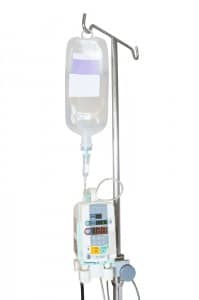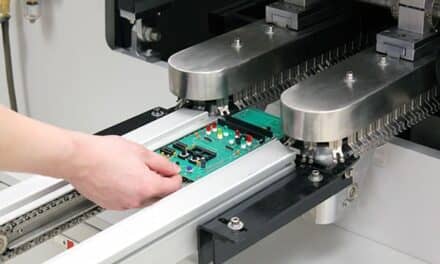
Many subtle factors can affect your IV pump testing results, causing them to vary from day to day or even during the same day. Controlling as many of these factors as possible, both large and small, can dramatically increase the consistency of infusion pump test results and help to make any real performance anomaly stand out.
Factors to Control, Independent of Testing Method
No matter what testing approach you use, several factors can have a big impact on pump performance. The exact degree of impact varies quite a bit between pump models. With a little experimentation, you should be able to assess the impact of these factors on your particular pumps.
Input fluid height. This is the distance from the water level in your IV bag to the infusion pump. Even on the best pumps we have seen, a difference of 10 inches in input fluid height will make a 1% difference in pump performance. This means that if you are testing all day and do not tightly manage your input fluid, your afternoon results will read lower than your morning results. On some pumps, the effect can be as much as 3%. Pump manufacturers usually recommend a specific range of fluid height for testing. This may not seem that important, but it really is.
Output fluid level. This is the distance in height from the output of the pump to your test instrument. For most manufacturers, the pump should be placed at the same height as the test equipment. The effect of output fluid height on pump performance is perhaps one half to one third as large as that of input fluid height, per inch. However, if the test device is moved down to the floor or up to a shelf, the effect on pump results can be bigger than that of input fluid height. Again, look for manufacturer recommendations.
Fluid temperature. There are two effects caused by variations in water temperature. The first, smaller effect is that the density of the water changes. If ambient room temperature changes from 20°C to 30°C, the density of the test fluid will change by about 0.3%. If you are bringing water in from a car or out of storage, the change in density can be even larger. Of course, this factor only causes an impact if you are using a scale to measure your output fluid.
The second, greater effect is that the water temperature will warm or cool the infusion set, which can affect the set’s mechanical compliance. Some manufacturers have specific recommendations regarding fluid temperature and processes for bringing the set up to temperature. On some pumps, infusion set temperature makes very little change in pump performance, while on others the effect can easily be 5%.
IV set age. The longer many IV sets stay in the pump, the more they become compressed and the material loses its ability to pop back to its intended resting shape. We have seen worn IV sets drop pump performance by more than 10%. With many pumps, you want to be sure to remove the set from the pump after testing is complete. Never leave the set in the pump overnight with the pump off. Your pump manufacturer may also have recommendations regarding handling the set and how long it may be used. In many cases, regular visual inspection may reveal signs of wear.
Additional Factors to Control When Using a Scale
IV pump output can be measured by running the output fluid into a container placed on the bed of a scale. The volume of the fluid is estimated from the weight by assuming that 1 g = 1 ml. While this approach seems straightforward, there are many factors to control for the results to be meaningful and consistent. Under laboratory conditions, with the best equipment, a great deal of care, and attention to detail, very accurate results can be obtained. But under field conditions, results are often degraded by the difficulty of managing all the necessary factors.
Managing “Drops.” If you just hang an infusion pump tube over a collection container, the fluid will dribble out in drops, typically about 0.03 g to 0.1 g per drop. If you are testing a 10 ml volume, that introduces 0.3% to 1% of inconsistency into the reading. For smaller test volumes, the percentage is greater.
Sometimes this problem can be managed by gently flicking the drop off the tube at the end of the test. But this can still result in inconsistent results: Sometimes fluid will remain on the outside of the tube afterward. Sometimes, flicking dislodges additional fluid from inside the tube and causes it to enter the container. If the prior reading left fluid on the end of the tube, and then the next reading pushes that extra fluid from the tube, you can still see an error of around 0.02 g to 0.05 g, even after trying to flick away the drops.
Needle selection. Because of this problem with drops falling inconsistently into the collection container, many testers prefer to use a needle that deposits the output fluid below the fluid level in the container. A couple of problems can arise with this approach. First, it is critical that the output hose and needle not touch the collection container at all, which can be tricky to rig. In addition, it is important to select the correct needle size. Too big, and the surface tension around the needle can cause a pull, decreasing the apparent weight of the fluid. Too small, and the needle can result in a high back pressure, which can decrease pump output. The AAMI standard calls for an 18-gauge needle, 1.2 mm in diameter.
Evaporation. Evaporation varies directly with exposed surface area, but also depends on relative humidity, airflow, and temperature. At 50% relative humidity, low airflow, and 25°C, something close to 300 g/h/m2 is typical. If your collection container is roughly a 5- x 5-cm dish, you should see evaporation of approximately 0.75 g/hr. If you are running a 10 ml test at 500 ml/hr, for example, the test will be short (about 0.02 hours, or 1.2 minutes), and the evaporation effect will be small (0.015 g = 0.15%), which you can usually ignore. But if you are running a low-rate test (say 10 ml at 10 ml/hr), the evaporation could be up to 7%, which you certainly cannot ignore.
Even with a short test, it is important that the result be recorded as soon as the test completes. If you are called away from the test before you record the data, you should consider rerunning it, as the results could drop 1% or more for every 10 minutes you are away.
There are several techniques for managing evaporation. Some methods include pouring a layer of oil on top of the water in your collection container if you are using a needle submerged below the water level, or placing your scale in a box with damp towels. But they are not very suitable for testing a large volume of pumps. Another strategy is to use a tall, narrow collection container to minimize the surface area.
Air Drafts. Air drafts have a substantial impact on scale readings. Draft shields can help, but many low-cost scales have no draft shield. In those cases, you can construct a draft shield from cardboard. But even with a draft shield, take care to place the scale as far away as possible from doorways and air conditioning vents.
All scales are designed to reduce the impact of environmental influences. Many have features that try to “filter out” drafts and other environmental influences by ignoring small, gradual changes in weight. In some cases, these features can be controlled by the user. However, since these features can have a number of undesirable effects on your reading results, we recommend disabling them if possible.
Scale care. Scales are very easily damaged and can be knocked out of calibration while being moved or shipped. Be sure to retain all the manufacturer’s shipping materials and any spacers that came with the scale. Repack the scale the same way it arrived from the manufacturer when you are moving or storing it. Some scales have a locking mechanism that can be engaged to protect the scale during transport.
Additional Factors to Control When Using a Graduated Cylinder
IV pump output can also be measured by running the output fluid into a container (such as a graduated cylinder or a burette) that has markings at different heights indicating various volumes. This is probably the simplest method of measuring pump output. The shortcoming of this approach is that its accuracy is low. Under most conditions, a reading of ±1 ml (10% of a 10 ml volume) can be obtained without much training or care. This is good enough to assess if the pump is basically functional, but not to evaluate its true performance. With care and training, however, the degree of accuracy can be improved.
Operator dependence. Many in the scientific community1 consider ±0.5 ml (5% of a 10 ml reading) as the basic error in a graduated cylinder reading. A reliable 1% accuracy at this volume may not be possible with a graduated cylinder, but it is likely that with care, skill, and practice the 5% can be improved upon. However, any such improvements are likely to be operator-dependent. To reduce operator dependence, operators can challenge and improve their measurement technique using an analyzer or scale as a reference.
Water splashing. Water is poured into a graduated cylinder from the top, but sometimes a drop will spray the cylinder wall above the fluid level or splash up after reaching the fluid level. Each drop of water that clings to the side of the cylinder can add 0.03 g to 0.1 g (or 0.3% to 1% of 10 ml) of error to the reading. If a burette is used instead of a graduated cylinder, water is introduced from the bottom, eliminating errors due to splashing.
Water sheeting on cylinder walls. Even a wide, short cylinder such as a 50 ml beaker can retain 0.2 g (2%) of a 10 ml volume on its sides after the water is poured out. As the cylinder becomes taller and narrower, the wetted surface area per volume increases. A tall, thin cylinder that would otherwise be good for precise reading can easily retain 3% to 5% or more of a 10 ml volume. This residual liquid will add directly to the error of your reading values. Drying the cylinder or burette between readings can remove these errors.
Additional Factors to Control When Using an IV Pump Analyzer
IV pump analyzers greatly reduce the number of factors that need to be controlled, and in most field conditions will produce more accurate and consistent data than other methods. Best results will be obtained if care is taken in selecting, maintaining, and using your analyzer.
Read the specs carefully. Designing and producing a pump analyzer that works as desired at all rates and volumes and on all pumps is an amazingly difficult task. Analyzer manufacturers have taken different approaches to this task with varying degrees of success. When performance is not ideal, analyzer manufacturers usually publish specifications that admit to the device’s shortcomings while at the same time staking claim to the areas where performance is good.
The result is that specifications can be very complex and difficult to understand. Take time to analyze specifications carefully, understanding any performance limitations, whether performance error is given in percentage of full scale or percentage of reading, etc. Sometimes your calibration service company can be a great resource for untangling confusing specifications.
Follow manufacturer recommendations on use, cleaning, and storage. Pay attention to special requirements for pump analyzer operation, such as test fluids. If the analyzer requires distilled or deionized water, do not use anything else. For example, saline will damage any analyzer.
Reach out for technical support if you have any problems or questions. If you are struggling to get your analyzer to work, there may be something simple in your setup that can be quickly resolved with good technical support. Just ask.
Improvements in IV pump analyzers are accelerating their adoption. Their use removes many factors that must be controlled when relying on manual testing methods. They are faster, easier, and their accuracy can only be approached by the best manual methods in the most controlled and pristine laboratory conditions.
However, where manual methods are used, careful technique can improve results. And no matter what measurement methods are used, careful attention to controlling the factors that impact pump performance (such as input fluid height, output fluid height, fluid temperature, and IV set condition) are key to obtaining meaningful data.
References
- Plambeck JA. Introductory University Chemistry I. Introduction: Error in Measurements. Available at: http://dwb.unl.edu/Teacher/NSF/C14/C14Links/www.chem.ualberta.ca/courses/plambeck/p101/p01017.htm. Accessed November 24, 2015.
Karl Ruiter is the founder and president of Pronk Technologies. For more information, contact chief editor Jenny Lower at [email protected].
Photo credit: © Sutisa Kangvansap | Dreamstime.com






I appreciate the refresher on IV pump testing. These are great tools to those wise enough to use them.